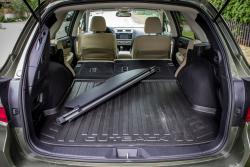Many years ago, the Subaru Outback was popular for a number of reasons. One, it was smaller and nimbler than a traditional SUV. Two, you could pretend to be Crocodile Dundee. Three, if you bought winter tires for the thing, you could be absolutely insufferable when the snow started flying, shaking your head in an exaggerated manner at the all-season-clad Canyoneros buried up to their side-mirrors in the ditches.
However, over the years the Outback has grown and become more popular, in a manner that you might say was the exact opposite of Paul Hogan’s career. That makes it more crossover than jacked-up wagon, and the similarly inflated price brings it into conflict with a new breed of crossovers that now dominate the Earth the way those SUVs once did. Enter the Highlander.
This newly-redesigned seven-seater from Toyota is simply gargantuan, but you get a V6 instead of a gas-sucking V8, relatively car-like ride and handling, and more flexible seating. It’s a kinder, gentler, squirrel-crushin’ deer-smackin’ driving machine. Hyah Canyonero II! Hyah!
With no seven-seater at present, Subaru’s Outback is left to take up the theoretical battle against the cars it has grown to resemble. These two overlap in price, and while the Highlander LE I had for the comparison was a little light on options, add the Outback’s six-cylinder into the mix and the gap grows even closer.
Both are rugged to a point, both offer all-wheel-drive, family-friendly capability, a relatively high level of efficiency, and real-world practicality. It’s didgeridoo versus claymore in the battle for suburbia.
Practicality
Any time I drive a modern seven-seat crossover, I’m reminded of just how not a seven-passenger vehicle it really is. Need to transport five kids around regularly? Get a minivan.
If you don’t, you’re left with twin flip-up rumble seats that eliminate the majority of your trunk space. The Highlander comes with a pop-open rear glass in convenience package cars that lets you stack things right to the brim, but ours didn’t have that.
That meant a space behind the deployed third row that’s a little tight. Toyota claims 390L, but I’d say it’s less than half of that if you only consider loading area below seatback level. You’re going to want to recline those seats from their straight-up-and-down default position too, cutting into space even further. Ferrying six adults and one toddler a distance of a few kilometres was just-doable, but the rear-seat passengers weren’t particularly happy.
Still, advantage Highlander. The Outback’s capacity is a hard cap at five, and that means the Toyota’s got the extra seating advantage when you need it – perhaps not for a long-distance road trip, but if you need to cram in a few extra kids on the way back from soccer practice.
    2015 Subaru Outback vs 2014 Toyota Highlander. Click image to enlarge |
For strapping childre- um, stuff on the roof, however, the Outback is tops. Not only is it easier to load, but also even the base model comes with roof racks. Our tester Highlander, an LE model, did not. They’re not part of the convenience package either, meaning you’d have to step up to an XLE to get them.
Towing things is to the caber-tossing Highlander’s advantage, with a stout 2,268 kg capacity. The Outback maxes out at just 1,224 kg with the four, and 1,360 kg with the six. It’ll handle a tent-trailer or a small aluminium boat, and if you’ve got to haul either of those up through the mountains, the 3.6L is not necessarily a must, just expect to be camping out in the right lane a little.
 2014 Hyundai Santa Fe XL Limited vs 2014 Toyo...
2014 Hyundai Santa Fe XL Limited vs 2014 Toyo...
June 4, 2014
 2014 Toyota Highlander LE AWD
2014 Toyota Highlander LE AWD
August 25, 2014
 2015 Subaru Outback
2015 Subaru Outback
August 4, 2014












